3 major Tips to consider for upcoming OTA brands
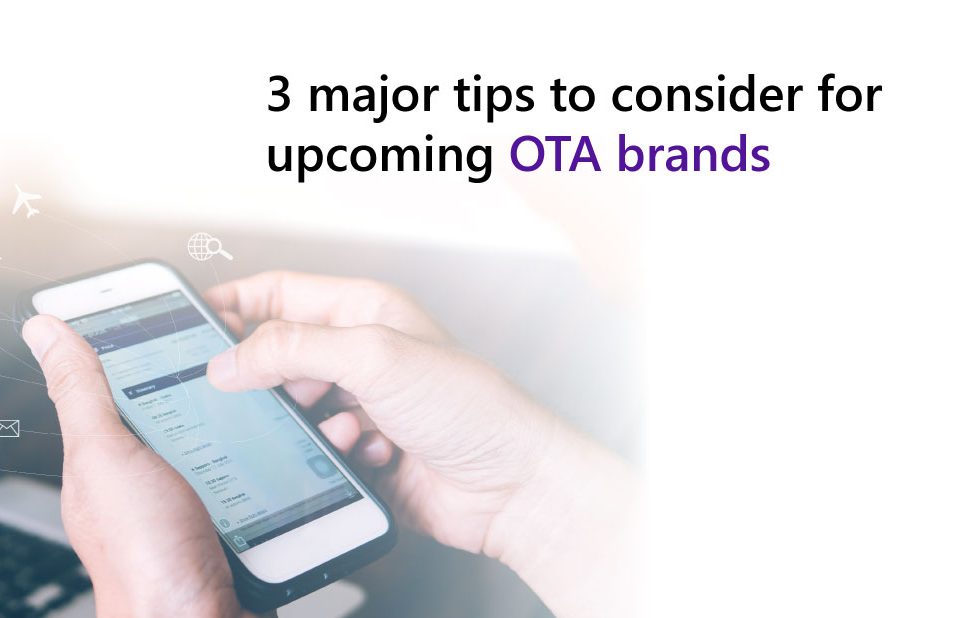
2022 was the recovery year for the global tourism industry from the damage caused by pandemic in 2020-21. There was an estimated 80% increase in the volume, the volume we are talking about is 1.8 billion international tourist trips. This figure decreased to 1.4 billion in 2021, and is estimated to approach 1.6 billion again in 2022. By 2030, there will be 1.8 billion worldwide tourists a year, according to the United Nations World Tourism Organization — 400 million more than last year, according to reports Given that, there is a huge surge where many entrepreneurs are developing Online Travel Agencies globally. There are three important building blocks of any OTA; Front End: The OTA app/website Back End: Booking Engine Supplier Side: GDSs, flight consolidators, bedbanks, wholesalers, aggregators If any of these elements are missing or if they are not given enough consideration, the project may fail in many ways. Here are the list of dangers that every aspiring OTA entrepreneur should keep in mind and plan accordingly. Lack of Unique properties Slow Booking Engine Speed Content Lack of Unique properties: There are estimated to be around 95 million properties globally with duplicate listings pushed by the bedbanks, GDSs, aggregators, etc. For any OTA platform, it is of utmost importance to make sure there are no duplicate listing of properties. Similarly, the suppliers tend to push the rates and availability of the same category room, multiple times. For Example, a category of Deluxe room, Ocean View, for a particular hotel may be displayed like “Dlx room, Ocn View”, “View Ocean, std dlx rm”, etc. which may come from different providers with different rates and availability, creating a confusion for the customers visiting the OTA leading to bad bookings, missed booking and awful user experience. Outsourcing a mapping provider is always recommended which can ensure the ratio of bad booking is reduced and provide a better user experience for the customers. Slow Booking Engine Speed: Customers want a fast, agile, intuitive booking engine where the results must be loaded on the fly. A booking engine is the heart of an OTA which performs searches, marking up rates, filter results, payments, invoicing and much more. If the engine fails to respond on time, the client may feel impatient and consequently OTA may lose the booking. The travellers visiting the website may lose interest and, in some cases, might end up leaving negative reviews on public fora. There are two options to fight this issue. Partnering up with Travel tech companies or developing an inhouse booking engine. Outsourcing is more reasonable than having an in-house tech team. Because, typically, outsourced development teams have more development experience in different fields. If an unusual problem arises, there is no need to hire new specialists for your in-house IT team. Your third-party vendor will do it for you with minimal effort from your side. So, with the proper planning, you can reach the same goal with a reasonable budget. Content: A rich, standard and unified content always attract customers. A website’s static content includes hotel information such as hotel name, hotel property images, hotel amenities, room descriptions, geocodes, hotel policies, and more. Each hotel may showcase the stay experience that they offer by using descriptive content. In fact, descriptive content changes are less frequent than dynamic content but need to be updated regularly. If the descriptive content is not regularly updated, then OTAs risk customer experience, and passing inaccurate hotel information to visitors, which eventually leads to missed business opportunities and revenue losses. Final Words! If you think the above-mentioned tips help, feel free to reach out to us to discuss in detail. Before concluding here are some final tips: Outsource as much as you can. This will keep the budget in place and help you reach your goals. Customer feedback is the key to build a great brand and continuous improvement in providing better user experience. In fact, every OTA should thrive on feedbacks. Finally, make sure the properties are unique on the website for driving quality traffic with high purchase intent. The rich, standard, and updated content is something that every customer seeks.
Hotel star rating system: Decoding it with Vervotech Curated Content
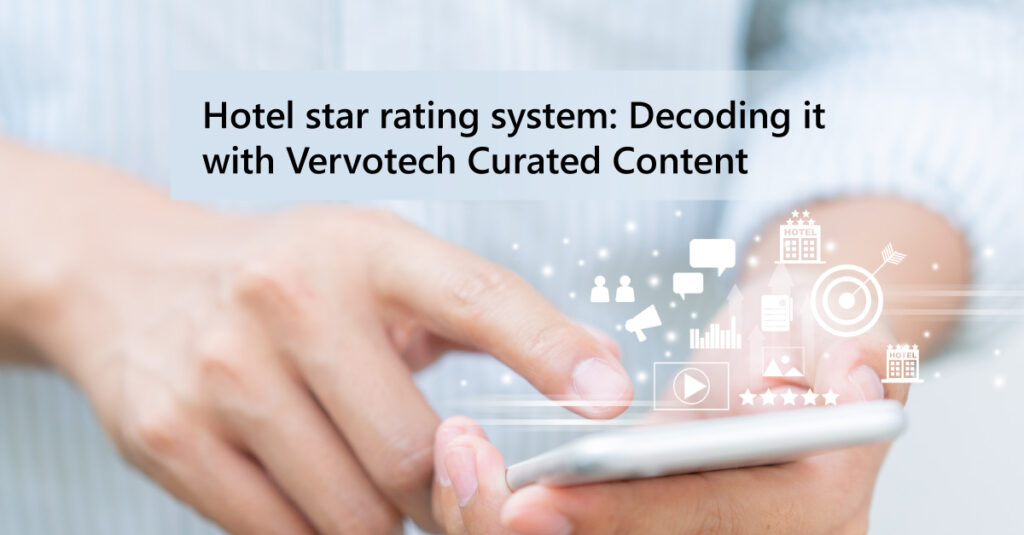
This is the situation with multiple properties worldwide. For example, Caesars Palace, Las Vegas, a 5-star property, is rated as 5-star by Booking.com but 4.5-star by Expedia. There is no standard star rating system worldwide, often creating confusion among travelers while booking a property. Furthermore, star ratings are valuable in customers’ booking decisions; star ratings portray a better picture of the hotel facilities and price. There is another layer of confusion around star ratings. Often hotel star ratings are confused with guest ratings. A guest’s star rating is based on their stay experience, whereas hotel stars indicate the property’s facilities and amenities. In this blog, we decode everything about hotel star rating systems and how Vervotech can help you streamline star ratings on your platform. Table of Content Defining hotel star rating system Different authorities for star rating systems Hotel star rating challenges for OTAs Conclusion Defining hotel star rating system Hotel star rating system is a process of grading hotel properties or accommodations (on a scale of 1 to 5) to make it easier for travelers to book a property based on their tastes, preference, and budget. Ideally, hotels are rated based on Hotel service quality Hotel facilities Design and architecture Cleanliness Luxury amenities Apart from the mentioned factors, hotels are evaluated these days on factors such as sustainable practices. Diving into the history of the hotel star rating system, the idea was coined by Mobil, a renowned oil company in the U.S. The company’s employees traveled the country and rated hotels on a scale of 1 to 5. Mobil Travel Guide is now known as Forbes Travel Guide and is considered one of the popular authority guides for rating luxury hotels. Forbes Travel Guide annually awards its ratings based on paid, anonymous, and in-person inspections. In North America, another prominent rating system, American Automobile Association (AAA), classifies ratings into 1-5 diamonds. Different authorities for star rating systems Unfortunately, there is no global standard for the hotel rating system. Internationally, several countries have star rating systems controlled by their government. Some of the renowned authorities around the globe are: HOTREC (Hotels, Restaurants & Cafés in Europe) Star Ratings Australia Salam Standard (for Muslim travelers) Green Key International (for eco-friendly accommodations) How do hotels achieve star ratings? The process is straightforward. The hotel owners need to register and apply for star certification to the governing authorities, and upon visiting the property, an audit is performed by the authority. The governing organization inspects the hotel based on the hotel star rating checklist. Based on the hotel star rating checklist, the authority inspects and rates the hotel between 1 to 5-star. Most of the hotels are categorized upon their ratings: 1-star rating: The minimal hotel 2-star rating: Standard hotels 3-star rating: Upscale hotels 4-star rating: Superior hotels 5- star rating: Luxurious hotels Interestingly, for properties that are 3-star and above, regular inspections are performed to check if the hotels are meeting the standards of the star rating systems. Hotel star rating systems challenges for OTAs As there isn’t any universal standard for star ratings, OTAs, tour operators, and metasearch engines often face credibility challenges with the star ratings listed on their platforms. When a hotel gets listed on these platforms, it can self-select its star rating. While many hotels select the star rating achieved by the authority, few hotels rate themselves more than the actual star rating, confusing the travel shoppers. That’s why OTAs and other travel platforms have added guest rating as another parameter to complement the star rating. Here, the travelers rate based on their stay experience. But this is an indefinite parameter for online platforms. That’s why we suggest opting for hotel content curation automation software which can provide you with accurate hotel star ratings. Vervotech Curated Content is an AI-powered tool that curates hotel content from multiple suppliers and delivers standardized hotel content. This enables OTAs to display accurate data on their website. We curate more than 40 attributes for our clients, such as hotel name, address, geocodes, room images, star ratings, and more. Below is an example of The Wallace, a 3-star property in New York, US. For this property, we assessed the supplier’s data with hotel star ratings and then ran our machine-learning models to determine the best average star rating. A comparative study with supplier data follows this. Image: Vervotech client portal How else do we validate our rating systems? We have integration with third-party services and social platforms to leverage their data for final verification. Also, we have a robust manual content analyst team that curates the hotel data, performs intensive research, and assigns accurate hotel ratings for the respective hotel. Conclusion We are in an era where hotel reviews and ratings matter a lot to customers. Hotel star ratings give an insight into the hotel property facilities and can impact customers’ booking decisions. Make sure your platform showcases accurate ratings that enable your users to choose a property easily for their holiday trip. Partner with Vervotech today to understand how we can help you display accurate hotel ratings.
AI-Driven Content Distribution & Management in Travel and Hospitality
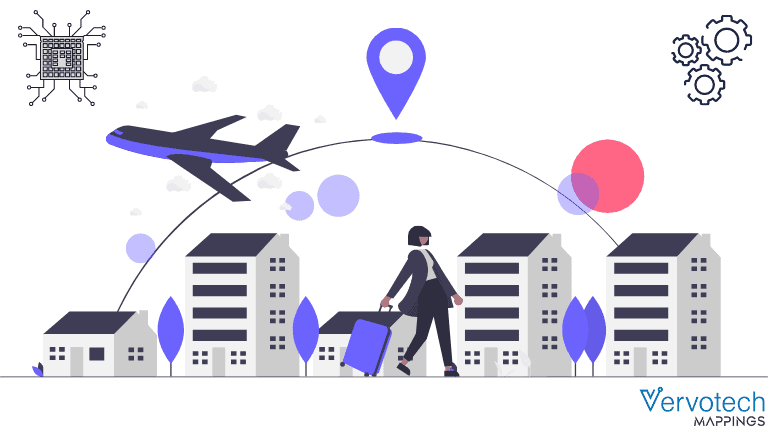
AI-Driven Content Distribution and Management is very important as we are entering into a new world of possibilities – the era of technological innovation! With major advancements in the technological capabilities of businesses, the limits are being pushed harder and further than ever before and at the core of this new world of possibilities, lies the twin pair of AI and ML, the holy grail and the hottest topic of discussion across global business circles. Therefore, it is essential that businesses today not only understand the meaning of these two terms and the ways that they are constantly impacting their industries but also incorporate the same into their existing mix so as to remain relevant within their market. So, what exactly are AI and ML? How are AI and ML being used by modern businesses when it comes to managing and distributing their content across their networks? These are some of the questions that we come across frequently, so let’s take a closer look at these two terms and strive to unravel the secrets behind the pair! What is AI and ML? AI or Artificial Intelligence, as the name suggests, is the simulation of human intelligence by modern machines through the process of repeated learning, correcting and reasoning. A machine, while being incapable of making decisions by itself, can process a large number of data sets quickly in order to reach certain conclusions. Once such conclusions are met, a machine can quickly identify whether that conclusion is favourable or unfavourable in nature. If the conclusion is unfavourable, the machine can quickly repeat the entire process till a favourable condition is met. Once this condition is met, the machine then registers that process and can apply it each time to reach a favourable conclusion without fail. This is called Machine Learning. Therefore, it can be seen that Artificial Intelligence and Machine Learning are intricately linked to each other where the application of Machine Learning leads to further models of AI with progressive levels of intelligence. We can then safely conclude that Machine Learning is a subset of Artificial Intelligence that continuously feeds computer systems with large amounts of data so that they can build relationships between data-sets and apply the same to the data-sets that are being fed. AI and ML in Travel and Hospitality Systems in the travel and hospitality sector aren’t much different – companies are increasingly applying AI-Driven Content Distribution into their technologies so as to make the systems faster and more efficient. When working with large sets of data, software that relies on AI and ML can quickly quantify data-sets in order to reach meaningful conclusions thus making the entire system extremely fast and accurate. For example, a supplier may be delivering content to multiple different sources multiple times a week. Since listings change quickly, it is essential that this data or content is constantly updated so as to provide the best possible listings to customers and cut down on losses due to erroneous listings. Here, a supplier may use AI and ML to automate the entire process where new listings will be automatically sent to specified points thus cutting down on valuable time and resources. Modern travel agencies need to constantly update their platforms and reflect the latest changes in bookings so as provide their customers with the most updated and accurate data possible. However, most of these travel agencies tend to work with multiple suppliers who are feeding data into their systems continuously. It is quite understandable that duplicates and inconsistencies will be present in the data when it is being consolidated from multiple sources. Therefore, this travel agency may apply AI-Driven Content Distribution in order to consolidate all incoming data and quickly identify the duplicates and get rid of them then and there. As it can be seen from the above two examples, AI and ML can be applied in every field in order to make the process more efficient, fast and intuitive. Whether you are a supplier who is supplying data to multiple sources or a travel agency that is consolidating data from multiple suppliers, you can use incorporate AI and ML into your existing systems in order to make them more efficient. AI and ML in Vervotech Mappings We, at Vervotech, believe in the power of technology to transform the entire value chain. With that thought process in mind, we developed Vervotech Mapping, a fully automated hotel and room mapping service that leverages the power of AI and ML to sustain coverage of 98% with an unmatched accuracy of 99.999%. These figures would not have been achievable without the incorporation of AI and ML into the mix. This divine pair has allowed us to not only develop a software that is able to automatically filter all incoming content for duplicates but also updates its servers through cloud-based systems multiple times a day so that our clients have access to the latest data possible. We are building and maintaining supervised and unsupervised ML models for augmentation and algorithm improvements. If you want to learn more about the ways Vervotech Mappings can help your business grow, click here for a guided tour of our features and services. Our support staff is always online and will be happy to guide you through the entire process!Vervotech Mappings is a leading Hotel Mapping and Room Mapping API that leverages the power of AI and ML to quickly and accurately identify each property listing through the verification of multiple parameters. With one of the industry’s best coverage of 98% and an accuracy of 99.999%, Vervotech Mappings is quickly becoming the mapping software of choice for all leading global companies operating in the travel and hospitality industry. To learn more about Vervotech Mappings and the ways it can enhance your business in the long run contact us: sales@vervotech.com
Mapping vendor evaluation: 5 key criteria for hotel providers to consider when evaluating mapping vendor
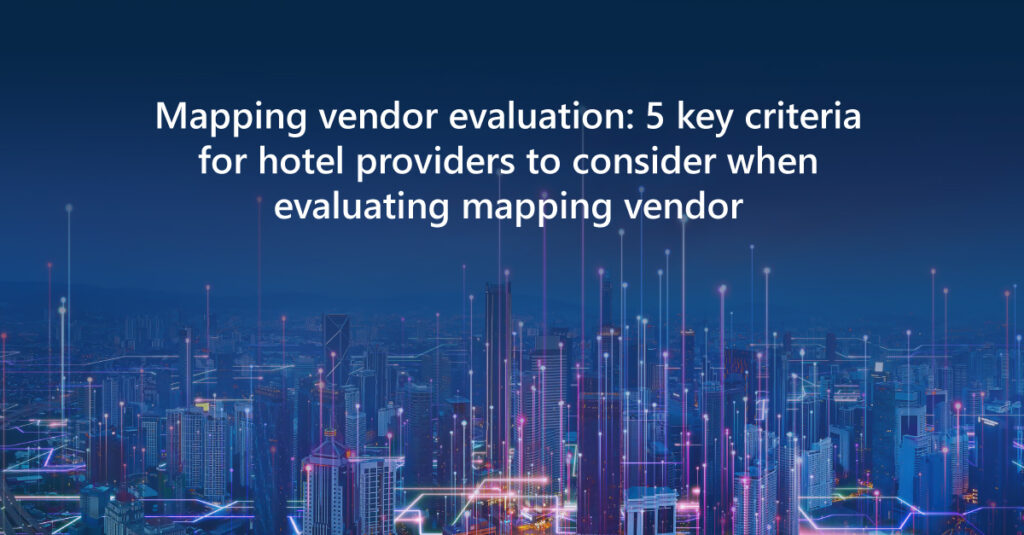
As a hotel supplier, it’s a nightmare to find your hotel inventory populated with duplicate hotel and room data. This can have a massive impact on your brand reputation, which has taken years to build. Duplicate hotel data mainly occurs because of multi-channel sourcing, where the hotel provider or distributor sources hotels from directly contracted hotels or other channels. To stay relevant and competitive in the market, hotel distributors must invest in mapping providers with the highest accuracy and mapping coverage. But how do you vet the right mapping partner for your business? We have curated an evaluation list to help you pick the right one. Let’s get straight into it. Top 6 considerations in mapping partner selection 1. Mapping the data irrespective of the source of inventory Hotel distributors working model involves contracting hotel inventory from multiple channels, directly from hotels, hotel chains, and third-party channels. A mapping partner must have the capability to map every property sourced by the distributor or travel agency. For example, if a distributor sources inventory from small hotel chains in Telluride, Colorado, the mapping vendor must be in a position to map all the hotels in Telluride. 2. Mapping percentage The next factor in evaluating your mapping partner is the mapping percentage. Find out the mapping process if the vendor follows automated mapping process or manual mapping process. Then, check the mapping percentage, i.e., how many hotel properties of the inventory are mapped. The higher the mapping percentage, the faster time-to-market for travel products. 3. Mapping process transparency As a hotel supplier, your main goal should be to distribute and sell all the hotels in your inventory. You can do this only if all of your properties are accurately mapped. And you can gather this insight if your mapping partner is completely transparent with their mapping process. For example, you have contracted 2,000 hotels in California, but you are distributing only 1,900 hotels in the region. Clearly, you are losing sales from 100 hotels, and you might not be aware of this error too. What can you do about it? Here it is your mapping partner who should inform and offer clarity to you about the mapped and unmapped ratio of your hotel inventory. Being transparent with the mapping process will help you make informed decisions in distributing and selling maximum properties to your customers. 4. Quick time to resolution Wouldn’t you appreciate a business that resolves bottlenecks quickly and accurately? The next parameter to vet a mapping vendor is how quickly they detect and fix any issue. The operational cycle should be fast, or else it can have a negative impact on revenue and customer satisfaction. 5. Attention to customized needs Opt for a mapping vendor that engages with your brand and supports your business requirements. The mapping partner should offer reports and analytics tailored to your needs so that you have insights on content quality and visibility into mapping coverage. The analytics should reveal which regions do you have maximum mapping coverage which area offers you better sales which region to improve coverage So that you can make informed decisions and increase customer satisfaction. 6. Offers hotel content It would be an added advantage if your mapping vendor even offered curated hotel content so that you, as a distributor, can enhance the quality of your hotel content and ensure accurate data is distributed to your customers. These parameters for how to find the right mapping vendor are the foundation for an improved booking experience. Take them into consideration while vetting a mapping provider, and you can find the right partner for your travel business.
Room Mapping – A Modern Tech
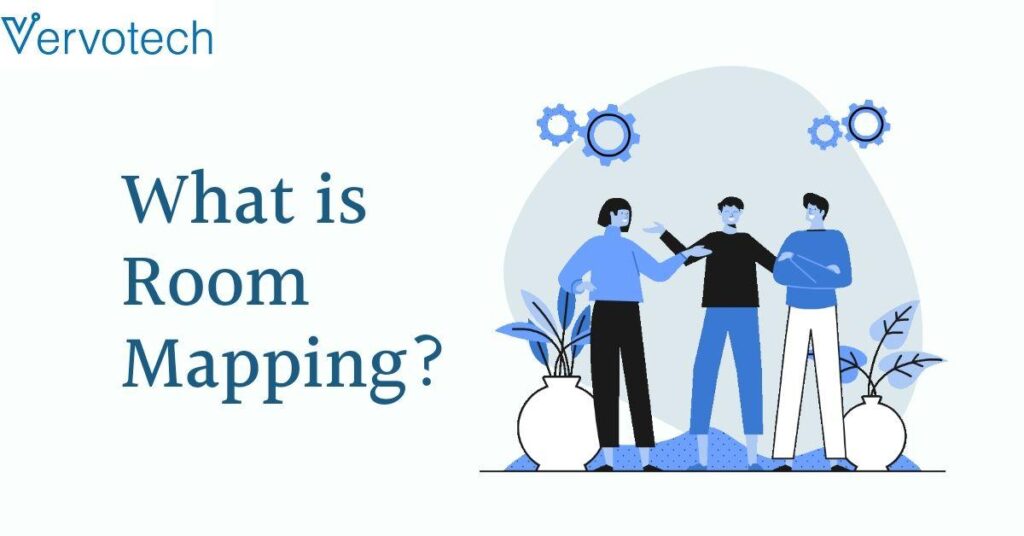
The turn of the millennium brought with it several technologies that completely transformed the global business environment. Technologies such as the internet and social media provided a lot of advantages to many businesses that were aware of the potential of these new media. As a result, the companies that were able to incorporate these newer technologies like Hotel and Room Mapping into their existing mixes enjoyed a certain competitive edge over the companies that relied heavily on traditional technologies. The travel and hospitality sector is no stranger to such changes having constantly transformed itself through the ages depending on the needs and requirements of society. The advent of the internet and social media platforms enabled travel and hospitality providers with a much-needed platform to showcase their listings. The 2000s saw the rise of several online travel agencies that aggressively expanded their markets in new and emerging markets due to the rapid boom of the travel industry. There were several reasons behind the shift in the industry: Shorter travel time between locations Better communication between long distances Easier access to information New and emerging markets in Asia, Latin America and Africa New opportunities through strategic business ventures Rise of the niche industries A shift in the mentality and psyche of people People are much more open towards online booking platforms today when compared to the general population before the internet revolution. This is because the internet provides people with a direct channel to market their products and services thus leading to better relationships between the provider and the consumer. Therefore, niche industries found their footing leading to a lot of more people travelling regularly for their business needs. The hospitality providers needed to understand the shift in the market and orient their ways to better meet the needs and want of their target market. Several technology companies started operations to meet these growing needs of the business when it came to optimizing their business practices. If businesses were to evolve into the digital era, they needed to do away with their archaic technologies and incorporate these newer ones to reach more audiences and provide better services. The shift towards an online business model by travel agencies was a step in the right direction but since the market was new, these companies struggled to find the most optimal ways to sell their products. What is Room Mapping? Room mapping has emerged in the 21st century as one of the leading services in the field that has more or less become a staple over the years. Mapping in the industry ensures accurate and precise data flow between various nodes thus removing duplicate and erroneous listings on any given platform. With modern cloud-based systems being able to handle thousands of transactions simultaneously, the need for proper, updated and unique listings on one’s platform is greater than ever. When a supplier or an OTA works with multiple suppliers or provides data to multiple other sources, mapping that same data and updating it across all channels can become an extremely tedious process. Hotel and room mapping APIs automate the entire process so that inconsistencies within the system can be removed with a simple click. Online Travel Agencies face the issue of duplication when it comes to rooms listed on their website. Every data provider provides each room of a hotel differently but in reality, the same room is listed multiple times with different attributes. Room duplication is a tedious problem since every supplier has different standards when it comes to offering room data. Room Mapping aims to improve the customer experience while finding the right room and optimizes profitability for the business. Room mapping is a process of identifying room level data via multiple parameters, detecting which room listings are the same and discarding duplicate results. It is carried out to display rooms accurately meanwhile sorting them by various filters according to the user’s preference. It is crucial to uniquely identify categories across multiple providers along with Room type, Description, Room ID, Amenities, Bed type, Policy, and much more for a better customer experience. Why Room Mapping? One of the biggest challenges faced by the travel fraternity is the lack of any global standard when it comes to distributing content. Each channel focuses on its own set of rules when distributing content and this makes it extremely hard for suppliers to consolidate the data that is being sent out. It has been established through years of research and simulation that cross table mapping is a multi-step process, i.e., the travel businesses usually send their data to a data management company which then converts that content into their own set of codes which are then represented in a huge XLS table. This process alone, if not automated, can take up to a month depending on the type of data that is being consolidated. This mapped data that is consolidated is then sent to the various travel businesses for sale on their marketplace. As the number of listings and overall conversions on platforms increases, manually mapping and updating this data is next to impossible. An automated AI dependent algorithm that instantly maps the data that is being consolidated across various supplier points will readily fasten up the process of mapping. Therefore, room mapping is quickly turning out to be one of the most essential and critical technologies in the travel industry, the absence of which can vehemently hamper the overall potential of any given business. If you want to read more about the history of room mapping and the attributes that you need to focus on, you can read our blog here that discusses in detail the role of accuracy and coverage in room mapping and the ways it can make or break modern travel businesses. You can also click here to learn more about us at Vervotech and the ways our AI-based room mapping API, Vervotech Mappings, are helping leading travel businesses worldwide consolidate their content.Vervotech Mappings is a leading Hotel Mapping and Room Mapping API that leverages the power of AI and ML to
3 Ways Metaverse Can Impact the Accommodation Industry
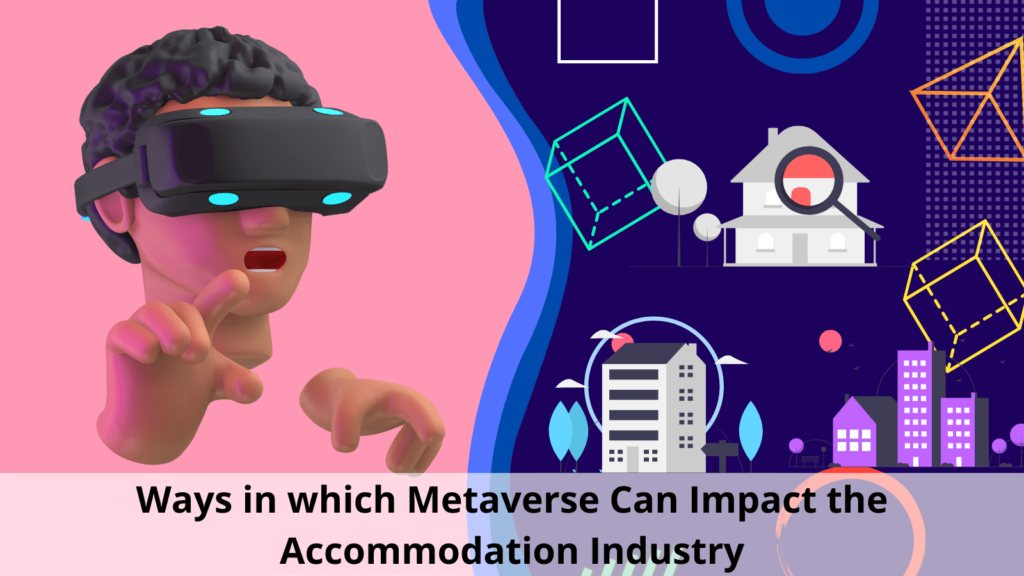
Metaverse has become the hottest buzzword that has gained popularity within a few months of its announcement. It is expected to become the next Internet revolution. Thanks to Mark Zuckerberg, CEO of Facebook who unveiled the rebranding of his social networking company Facebook to Meta Platforms. Ever since the announcement, metaverse has got everyone’s attention. From brands such as Adidas, Nike to tech companies such as Microsoft, Nvidia, every company wants a slice of the metaverse. According to a Bloomberg Intelligence report, the metaverse market is expected to reach $800 billion by 2024. What is Metaverse? Metaverse was first coined in 1992, by sci-fi author Neal Stephenson in his novel Snow Crash, where he envisioned a digital 3D world in which users turned into avatars and interacted in a shared online space. It is a parallel interactive world that leverages augmented reality (AR), virtual reality (VR), and mixed reality (MR) where users can virtually live within a digital world with the help of digital avatars. It will be more like our real world, where people can play games, celebrate birthday parties, go to a concert, work, shop and even own a piece of land! However, everything about metaverse is hypothetical, yet. The irony is despite being hypothetical for now, It has seen massive investments. For example, in late November 2021, digital asset investor Tokens.com purchased a virtual plot of land in the Decentraland metaverse platform for $2.4 million worth of cryptocurrency. And digital real-estate is just soaring high, making it a multitrillion-dollar market. Even though we are years away from it, the investments and rapid developments could make it a reality soon. And after retail and tech companies’ big bets on the virtual world, the hospitality industry must definitely try to incorporate metaverse too. Metaverse in Hospitality Industry Global travelers rely heavily on modern technology, especially the younger generations such as millennials and Gen Zs. From mobile check-in, bots, to QR-coded menus, technology has become the backbone of a successful guest experience. Metaverse can take the personalized guest experience to the next level. If hotels bring a flavor of a metaverse in their customer experience strategy, then there could be a huge potential for them to improve their business performance and revenue. Let’s find out three ways metaverse can transform the accommodation space. 1. Redefine guest booking experience When the modern traveler plans for any holiday trip, they expect a smooth and memorable journey. And it begins right from accommodation research. With metaverse, OTAs and hoteliers can provide their customers with a first-hand experience of room booking, such as room size, amenities, value-added services, etc. This ‘try before you buy’ experience will give a sense of confidence to the traveler before booking their stay. Additionally, this will increase the direct booking rate and improve business revenues. Recommended: Five Ways World Travel Industry Digitalizing Journeys 2. 3D virtual hotel tours Who wouldn’t love a virtual hotel or resort tour before finalizing a hotel property for a holiday or business trip? Many companies offer virtual, 360-degree, 3D hotel tours to attract visitors, but with metaverse in place, travelers can be transported to the hotel property and virtually walk through the entire property and decide whether it matches their tastes. This will make it easier for them to choose and help hoteliers to gain more customers and get an edge over their competitors. 3. Virtual itinerary According to a new study, more than eight in ten American Gen Z and millennial travelers desire a unique experience for their next trip. With metaverse, hotels and resorts can give their guests a virtual itinerary about the nearby landmarks, museums, historical sights, etc. that can enrich their experience. Additionally, hotels can even offer personalized itineraries based on their needs and likings, which will improve guest engagement and help hotels remain competitive. Recommended: Five Emerging Technology Trends in Travel Industry What is the Future of Metaverse? Metaverse in the hospitality industry will create a personalized experience that will build brand loyalty. Currently, there is a mixed reaction for metaverse in the hospitality industry. Thought leaders are seeing a huge market for metaverse, while some believe it can’t replace the feeling of authentic traveling through digitization. However, consumers, especially the younger generations are excited about metaverse. Once metaverse is in action, only the early adopters can reap its benefits. Now is the time to identify where and how can the accommodation industry accommodate metaverse to satisfy the changing needs of tech-savvy travelers.Vervotech Mappings is a leading Hotel Mapping and Room Mapping API that leverages the power of AI and ML to quickly and accurately identify each property listing through the verification of multiple parameters. With one of the industry’s best coverage of 98% and an accuracy of 99.999%, Vervotech Mappings is quickly becoming the mapping software of choice for all leading global companies operating in the travel and hospitality industry. To learn more about Vervotech Mappings and the ways it can enhance your business in the long run contact us: sales@vervotech.com
Big Data in Travel
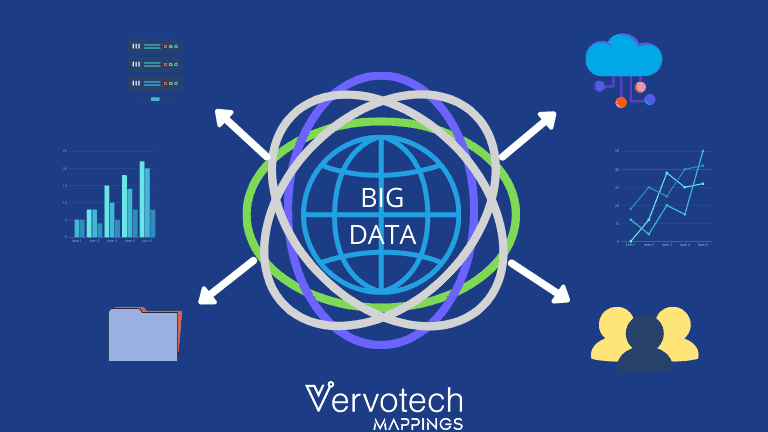
The modern trade environment is a mix of various factors that are continuously interacting with each other in an ever-increasing manner. How do stakeholders keep up with the changes that are affecting their immediate business market in order to understand the needs and wants of the customer to innovate and stay relevant? One of these factors is big data – a term that is increasingly gaining relevance in a modern context. With that thought, I am writing about big data and the various ways it is transforming businesses. What is Big Data? Big data means exactly as the name suggests – big data or data that has been accumulated over time which has resulted in a large quantity of the same. If we want to get a bit more technical, we can define big data as the evolution and use of technologies that provide the right user at the right time with the right information from a mass of data that has been growing exponentially for a long time in our society. As we all know, information plays a critical role in today’s society and the entities that have access to the right information has a certain competitive advantage in the market. With major developments in technology, the needs and the wants of consumers worldwide are changing rapidly along with the channels that they use to avail these products. It is now possible for one to avail services or purchase products right from the comfort of their own homes, a concept that was quite alien even a couple of decades ago. However, with the world being increasingly connected through the emergence of the internet of things, people are growing more used to their devices being always connected to the internet. This not only provides them with access to certain products and services, it also provides companies with a key opportunity to reach these customers through these innovative new channels. How can one then make use of such channels? The digital data produced is partly the result of the use of devices connected to the Internet. Thus, smartphones, tablets and computers transmit data about their users. Connected smart objects convey information about a given consumer’s use of everyday objects thus providing companies with critical data regarding their usage stats and preferences. This data can then be used by companies to better their products and services or market them accordingly. This large treasure trove of data that companies can accumulate overtime on their users and the target market is called big data and it is being applied in every field to transform entire industries. Big Data in the Travel Tech Space The travel industry is no stranger to big data. As discussed earlier, modern developments are constantly changing the way people avail products and services with many now solely depending on the new media for all their day-to-day needs. With the travel & tourism industry expanding exponentially due to the introduction of these newer technologies, suppliers, as well as travel agencies, have to constantly deal with large sets of data or essentially, big data. Since access to information drives the overall business for any modern company, big data has become a top priority in the travel and tourism industry. With big data at your fingertips, it becomes easier for you to create a customer profile for your product, understand your main target groups, analyze their behaviours and preferences and ultimately deliver a highly customized experience to the consumer. This not only increases the chances of closing a sale but also increases the chances of retaining a customer due to a seamless customer experience. The following are some of the areas where big data is being used to better services: Revenue Management: It is essential for a business to sell the right product to the right customer at the right time for the right price via the right channel in order to maximize their financial capabilities. Big data plays a key role in this regard by providing companies with invaluable data related to customer buying behaviour and their preferences. Certain internal data sets such as occupancy rate, room revenue and current bookings can be combined with relative external data sets such as local events, holidays and weather to better predict and anticipate demand thus allowing them to price their rooms accordingly. Reputation Management: As evident from the title, reputation management refers to the strategic management of one’s reputation across channels. With newer media on the rise, it is possible for one to leave reviews on the internet regarding products and services that they avail in order to enhance the experience of others. Nowadays, reviews on social media platforms and eCommerce websites have become one of the major ways that customers value their products. With companies selling their products and services via multiple channels, it becomes extremely hard to analyze and review all comments left behind by users through physical means. Big data can help quickly review these for a better understanding of the points of satisfaction (or dissatisfaction) in terms of customer service to better develop training modules for employees. This can help ensure positive reviews in future thus driving the overall sales for the company. Strategic Marketing: Simply advertising and marketing your product does not cut it anymore – it is essential that a company is able to market its products through strategic means in order to maximize reach. As it stands today, it does not make much sense for companies to market their products to a single target market or a specific customer profile. This only limits their reach and stagnates growth. However, potential customers can be extremely varied and dynamic as they will have different needs and wants depending on their demographics. Big data can help companies identify the main trends in any given market in order to ascertain and develop strategic marketing opportunities thus enabling them to make the right products visible to the right customers. Marketing emails and push messages can be sent based on these large data sets thus allowing for a much more effective approach towards marketing.
Traits of a Successful Travel Management Company

The turn of the millennium brought with it several technologies that completely transformed the global business environment. Technologies such as the internet and social media provided a lot of advantages to many businesses that were aware of the potential of these new media. As a result, the companies that were able to incorporate these newer technologies into their existing mixes enjoyed a certain competitive edge over the companies that relied heavily on traditional technologies. The travel management companies is no stranger to such changes having constantly transformed itself through the ages depending on the needs and requirements of society. The advent of the internet and social media platforms enabled Travel Management Companies with a much-needed platform to showcase their listings. The 2000s saw the rise of several online travel management companies that aggressively expanded their markets in new and emerging markets due to the rapid boom of the travel industry. There were several reasons behind the shift in the industry: Shorter travel time between locations Better communication between long distances Easier access to information New and emerging markets in Asia, Latin America and Africa New opportunities through strategic business ventures Rise of the niche industries A shift in the mentality and psyche of people People are much more open towards alternate business opportunities today when compared to the general population before the internet revolution. This is because the internet provides people with a direct channel to market their products and services thus leading to better relationships between the provider and the consumer. Therefore, niche industries found their footing leading to a lot of more people travelling regularly for their business needs. It was essential that the travel management companies understood the shift in the market and orient their ways to better meet the needs and wants of their target market. Several technology companies started operations to meet these growing needs of the business when it came to optimizing their business practices. If businesses were to evolve into the digital era, they needed to do away with their archaic technologies and incorporate these newer ones to reach more audiences and provide better services. The shift towards an online business model by travel management companies was a step in the right direction but since the market was new, these companies struggled to find the most optimal ways to sell their products. According to certain studies, during the mid-2000s, companies started pricing their products competitively due to the increase in competition in the market. This led to a loss in revenue and the hospitality industry was struggling to provide its services at the stipulated prices. The market collapse of 2008 further worsened the situation and companies were scrambling to find their footing in an extremely saturated market. The disruptive business model introduced by Airbnb was considered a threat to the hotel industry but played a critical role in paving the way for travel agencies to modernize their services. Most travel agencies realized the need for major changes in their business model and pricing strategies to attract larger audiences – a factor that enabled Airbnb to grow rapidly and expand its services to global markets. Content management and distribution were determined as two key factors that affected the overall credibility of any online business and companies that were able to adopt technologies that automated their content management was able to provide better services to their end-users. Reliability on online service providers was still on the rise though as the internet provided an ease of access that could not be matched by any other platform. During the early-2010s, the smartphone became a staple and people had constant access to the internet through their smartphones further increasing the dependency on online platforms. Since the number of bookings was constantly on the rise, there was a need for companies to update their listings as frequently as possible to reflect the latest changes in listings and provide the best possible choices to customers. Therefore, it can be seen that there are several factors that determine the viability of an accommodation provider in a modern context: Accessibility: A modern accommodation platform needs to be accessible to all potential customers. This means adopting a business model that focuses on both online and offline selling. Visibility: A platform needs to be visible to attract a large number of audiences organically. It does not make much sense to have a presence on different mediums without optimizing one’s visibility to end-users. Affordability: It goes without saying that customers will buy from platforms that provide the best value for their money. Therefore, a modern accommodation provider needs to be affordable and provide packages for all types of tourists and travelers. Technology: The technology adopted by any given company determines its overall quality of service and effectiveness. Therefore, a modern accommodation provider must incorporate the latest technologies into their existing systems. Quality: Quality has always been one of the drivers of businesses since ancient times. Any company operating in the service sector needs to provide the best quality of service to remain competitive in the market. Sustainable: Sustainability practices are quickly becoming one of the most important factors that determine the viability of any modern business. Customers of the new age prefer companies that are sustainable since it positively impacts their psyche. In addition, sustainable practices also cut down on losses for the company through the incorporation of progressive models. Environment-friendly: The impacts on the environment and climate change are two of the most important challenges faced by humans at present. The travel and hospitality industry has long been associated with environmental degradation and there is a dire need for the industry to change their practices. However, most companies are now focusing their resources on sustainable practices and that has somewhat restored faith in the industry. Support: Support is a key aspect of any business operating in the service sector. Companies must provide multiple channels of support to their consumers to maintain good relations and maintain their brand image and value in the market. These are some of the key factors that
What’s the Importance of Mapping Speed in Hotel Mapping?
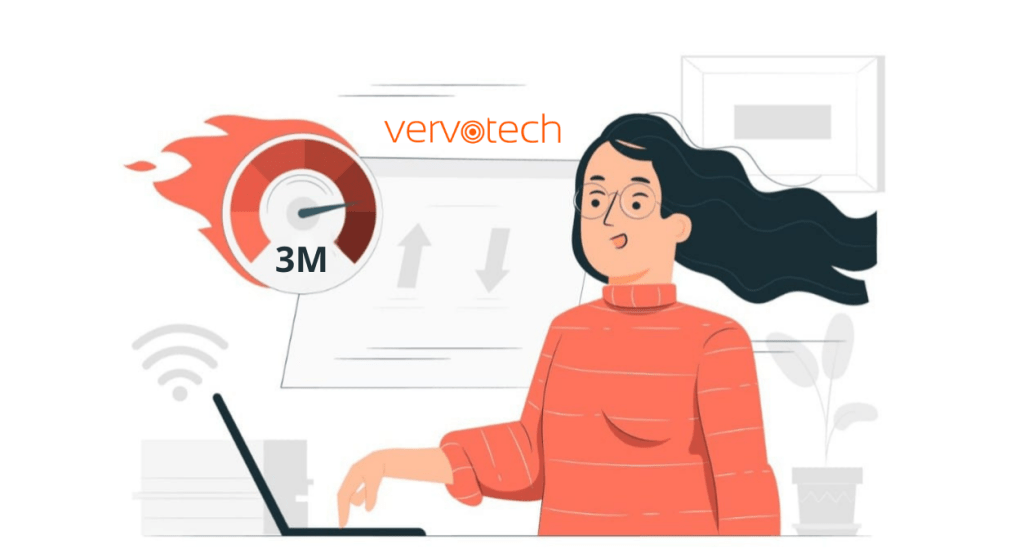
The hospitality distribution market is one of the most complex and largest among the other rival industries in a relative sense. For Hotels and OTA’s today, accurately merging multiple sources of data from suppliers is extremely challenging due to a lack of global standards. Managing a large database and providing the best hotel content to online users is one of the most tedious tasks when done manually due to the increments in data sets that companies need to work with regularly. Due to these large databases, the data displayed isn’t the same everywhere and can result in errors in booking all over the platform. At the centre of these challenges, the issue of tackling duplicate records stands as the most arduous task that needs to be addressed by modern global hotel OTAs, suppliers and distributors alike. To meet this need of the travel industry, travel technology companies are quickly starting to prove their worth. Travel tech companies are providing the industry with smart and intelligent solutions to give online users a seamless and hassle-free booking experience thus ensuring their retention in the long run. The technology that helps to resolve this issue of duplicate listings is called hotel mapping – a service that quickly identifies duplicates and ensures consistencies in hotel and room listings on any given platform. What is Hotel Mapping? Hotel mapping refers to the process of merging different property IDs from different suppliers into one unique property ID and providing users with unified and opinionated content. Duplication and inconsistency in hotel content usually occur when an OTA sources its data from different channels like the bed banks, GDSs, larger OTA’s, etc. that do not really conform to the same standard of distribution. Hotel Mapping is an excellent solution that adapts to online consumer needs. Hotel mapping can be done manually too but looking at the large databases that companies need to work with regularly today (that is constantly increasing) it can be an extremely tedious, time-consuming and labour-intensive process. To avoid this major problem of duplication and inconsistent listings, most of the OTA’s opt for automated hotel mapping platforms and aims to prevent the end-user from booking the wrong duplicate hotel. If you want to learn more about hotel mapping, we highly recommend going through this blog Hotel Mapping, where we delve into a much more detailed analysis of the topic. Does Mapping Speed matter in Hotel Mapping? In this fast-paced lifestyle and evolving travel businesses who wants to be a turtle in the race? Today, online users are searching for millions of properties every second and they want the best hotel rooms at the best prices within seconds. As a result, all suppliers and distributors in the ecosystem want to make sure that they can push the latest updated content of hotels in real-time for greater coverage. Today, over 148 million online travel bookings are made annually and for an OTA losing a customer due to poor online service can break their business. To overcome this pain point, most of the OTA’s are looking at automated hotel mapping software with high processing speed and accuracy so as to maintain consistencies across their platform. It is essential that the listings being made available to potential customers on online booking platforms are both accurate and updated so that the best possible properties can be displayed according to the search query. If multiple listings are present on a platform that relates to the same property, it ends up confusing the customer and results in incorrect bookings. Such incorrect bookings can not only incur losses but can seriously threaten the viability and damage the credibility of a brand over time. This pandemic has taught businesses to manage their finances smartly by not letting even a single user trickle through when it comes to conversions. In such a competitive market, giving users an easy and seamless booking experience has now become the most critical focus point for all OTAs. To provide users with fast and opinionated results, a fast hotel mapping tool is of utmost importance. Therefore, to answer the question, speed is definitely important and one of the most critical factors that contribute to the efficiency of any given system in the distribution network. We, at Vervotech, understand the importance of the role we tech companies play in the travel industry and we are constantly working towards bettering our products and services to better serve the travel businesses. Our AI-based hotel mapping API, Vervotech Mappings, leverage the power of machine learning to uniquely map hotel content with a 99.99% accuracy and can uniquely map hotels with a mapping speed of more than 3 million properties per day. Pretty cool, isn’t it? What’s cooler is the fact that we push updates multiple times a day with a coverage of over 98%! If you want to learn more about our hotel mapping software and the other services offered by Vervotech, visit us here for a guided showcase of our products.Vervotech Mappings is a leading Hotel Mapping and Room Mapping API that leverages the power of AI and ML to quickly and accurately identify each property listing through the verification of multiple parameters. With one of the industry’s best coverage of 98% and an accuracy of 99.999%, Vervotech Mappings is quickly becoming the mapping software of choice for all leading global companies operating in the travel and hospitality industry. To learn more about Vervotech Mappings and the ways it can enhance your business in the long run contact us: sales@vervotech.com
5 Reasons Why Your Travel Company Needs Hotel and Room Mapping Tools
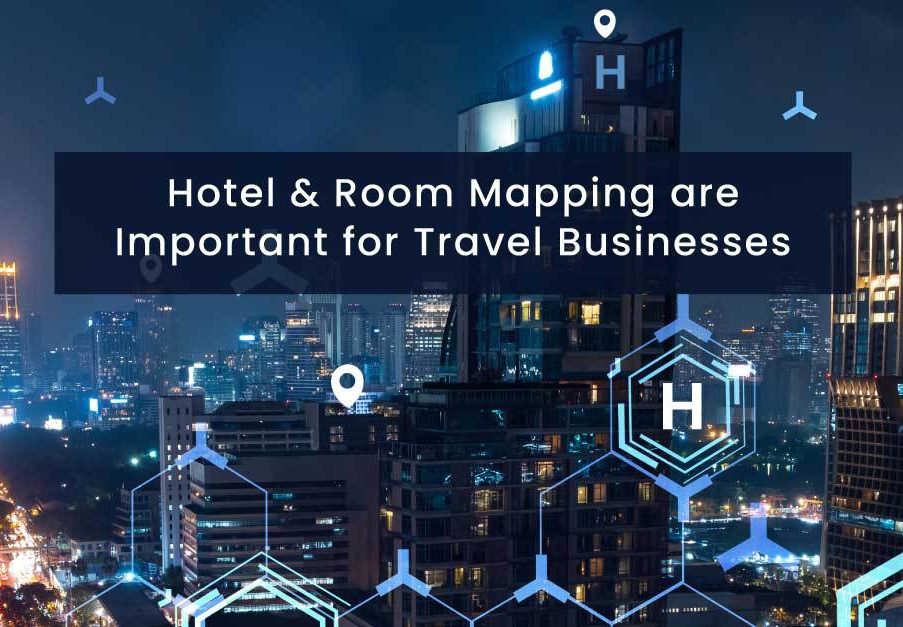
Are you an OTA or hotel distributor? Do you end up paying a refund to your customer by selling the wrong hotel or room due to duplicate or wrong or poor inventory description? If yes, then you need to understand hotel and room mapping. Currently, the accommodation segment of the hospitality industry relies on multichannel distribution to gather hotel data. Different accommodation providers such as metasearch, OTAs, tour operators, bed banks, consolidators, intermediaries, and suppliers, display the unique names of the exact same hotel or room, leading to duplication and bad customer experience. This ongoing industry-wide challenge can be solved through hotel and room mapping tools. Hotel mapping tool aggregates data of various hotel properties from different sources, resulting in standardized and unified hotel data. Some of the hotel data are hotel name, hotel address, geocodes, property type, hotel images, etc. Whereas room mapping tool works in a similar fashion as hotel mapping. It intelligently analyzes, identifies and sorts multiple rooms sent by different suppliers via various parameters such as room type, amenities, bed type, description, policy, etc., so that the same room does not get listed on your portal twice. Let’s dive into why your travel company needs hotel and room mapping tools. Why Hotel & Room Mapping are Important for Travel Businesses Here are five reasons why any business that sells hotels or rooms should invest in hotel and room mapping tools. #1 Remove duplicate hotel and room listings When tour operators or OTAs source hotel data from more than one supplier or distribution partner, there is a possibility of duplicate hotel data and inconsistent hotel listings. This duplication issue can hurt your travel business and end-user experience. To solve this, every travel business must invest in hotel mapping software. Automated hotel level mapping tool delivers standardized hotel data for each property and removes duplicate listings from your hotel inventory. Similarly, room level mapping provides enriched room content, both descriptive and illustrative, with zero duplicates. Recommended: Hotel Data Duplication: How To Solve The Growing Challenge For Hospitality Industry #2 Up-to-date hotel and room data Did you know your travel platform could be selling stale hotel content that could impact your business and customer experience? Stale content majorly occurs when you don’t keep up with the constant changes that hoteliers make, such as room availability, address change, new upgrades in amenities, etc. The ideal way to optimize hotel and room data is through mapping tools. Hotel and room mapping removes outdated and incorrect information and provides an up-to-date hotel property list and room content. This will ensure that your platform has the freshest content for your customers, enhancing your customer retention and brand loyalty. #3 Maximum hotel inventory coverage Did you know OTAs, tour operators sell only 60% of the hotel inventory? This results from unmapped hotel inventory, leading to business loss and missed booking opportunities. Hotel and room mapping gives you a business advantage to sell hotel inventory that was previously out of sight to customers. Currently, leading mapping providers offer maximum hotel coverage of 98%. #4 Hotel data ownership on distribution channels As an accommodation provider, it’s easy to lose ownership of your data in the swarm of multichannel distribution. But with the implementation of hotel and room mapping, you instantly regain control over how your data is showcased on distribution channel websites or portals. Mapping ensures that any change in your property listings is instantly reflected in the master database of the distribution partners. This way, irrespective of how often your data is distributed, you have complete ownership of your hotel and room data. #5 Smooth content distribution Due to the fragmentation of distribution channels, it becomes difficult for travel businesses to distribute hotel and room content efficiently. This causes data inconsistency, data unavailability, data loss, stale data. The good news is hotel and room mapping simplify hotel content distribution smartly, letting travel businesses focus on revenue-generating tasks and business-critical functions. As a travel business, you must have hotel and room mapping in your distribution strategy. Without mapping, your platform might have duplicate listings, inaccurate data, stale information, which can directly lead to revenue leakage, impact your customer booking experience and put your brand reputation at stake. It’s time to leverage technology, make mapping part of your business strategy, and deliver a frictionless end-user experience. Vervotech is a leading Hotel Mapping and Room Mapping API that leverages the power of AI and ML to quickly and accurately identify each property listing through the verification of multiple parameters. With one of the industry’s best coverage of 98% and an accuracy of 99.999%, Vervotech is quickly becoming the mapping software of choice for all leading global companies operating in the travel and hospitality industry. To learn more about Vervotech and the ways it can enhance your business in the long run contact us: sales@vervotech.com


